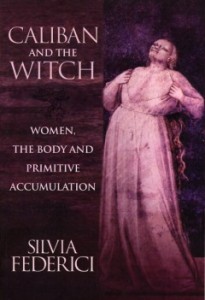 Federici, Silvia. 2004. Caliban and the Witch: Women, The Body, and Primitive Accumulation. Brooklyn, NY: Autonomedia.
Federici, Silvia. 2004. Caliban and the Witch: Women, The Body, and Primitive Accumulation. Brooklyn, NY: Autonomedia.
It’s become almost cliché to say that taking into account gender—and other forms of social difference—makes a real difference for how we build our theories, our analysis, and our political praxis. But few books that I’ve read recently have proven this rule of thumb so resoundingly as Silvia Federici’s Caliban and the Witch. This is an extraordinary intervention in how we think about primitive accumulation and the origins of capitalism. Federici details how the onslaught against women’s social position—particularly, through repression as “witches”—was a historical precondition for the advancement of capitalism. She concludes, “Primitive accumulation has been above all an accumulation of differences [particularly, race, age, and gender], inequalities, hierarchies, divisions, which have alienated workers from each other and even from themselves” (115).
As for the title of the book: “Caliban” represents the rebellious world proletariat writ large, while the “Tempest” is the “embodiment of a world of female subjects that capitalism had to destroy: the heretic, the healer, the disobedient wife, the woman who dared to live alone, the obeha woman who poisoned the master’s food and inspired the slaves to revolt” (11). Federici describes how all these forms of social insubordination, which were at one time accepted even respected practices, were criminalized through the figure of the witch, laying complimentary (and necessary) conditions for the enclosures that spurred the first inklings of capitalist relations. Above all, this repression and criminalization meant the “development of a new sexual division of labor, confining women to reproductive work” (14). The body itself became a primary “site” of both exploitation and resistance; it became “appropriated by the state and by men and forced to function as a means for the reproduction and accumulation of labor” (16).
For women to be subordinated to the production and reproduction of labor-power, the repression of “witches” proved fundamental for the breaking the control that women exercised over their bodies and reproduction. Federici powerfully writes:
Just as the Enclosures expropriated the peasantry from the communal land, so the witch-hunt expropriated women from their bodies, which were thus ‘liberated’ from any impediment preventing them to function as machines for the production of labor. For the threat of the stake erected more formidable barriers around women’s bodies than were ever erected by the fencing off of the commons. (184)
She begins by showing the role played by women in social movements during the feudal period, highlighting the intense labor struggles that became articulated with millenarian and the heretic religious movements—a kind of liberation theology for those days. Despite the threat posed by the growing monetization of the feudal economy, Women’s activities in markets and the growth of urban centers was affording them greater independence and solidarities in their lives. And the labor-power drain caused by the Black Death this period also marked an unprecedented moment of worker power.
But Federici traces how women became particularly criminalized amid this political effervescence—contraception, for instance, being posed as a particularly threatening practice (39). Sexual violence by men against women further fractured cross-gender class alliance through the veritable legalization of rape—particularly of poor women (47). Autonomous forms of control over women’s bodies through contraceptives, for instance, led to an increasing criminalization of these practices (39).
Perhaps the most fateful transitional point for capitalism, according to Federici, was the increasing monetization of the feudal economy in which the reproduction of labor-power and its elementary role in accumulation became valueless “women’s work” (75). The division between production and reproduction meant women were also dispossessed (of lands), but unlike men were discriminated from receiving waged labor, reinforcing their dependence and invisibility. Increasingly marginalized, women sought work elsewhere in places like bordellos and ale houses—further criminalizing and devaluing their labor.
Women lost their autonomous legal status precisely at the moment when questions of population and labor force became increasing state concerns, which further politicized the politics of reproduction, which was a driving force of the witch-hunts (89).
If we consider the historical context in which the witch-hunt occurred, the gender and class of the accused, and the effects of the persecution, then we must conclude that witch-hunting in Europe was an attack on women’s resistance to the spread of of capitalist relations and the power women had gained by virtue of their sexuality, their control over reproduction, and the ability to heal. (170)
In terms of healers and midwives, this was also an enclosure of knowledges: “With the persecution of the folk healer, women were expropriated from a patrimony of empirical knowledge, regarding herbs and healing remedies, that they had accumulated and transmitted from generation to generation, its loss paving the way for a new form of enclosure” (201).
In terms of primitive accumulation and other “leaps” toward capitalism, Federici says: “The advantages which the capitalist class derived from the differentiation between agricultural and industrial labor and within industrial labor itself — celebrated in Adam Smith’s ode to pin-making — pale when compared to those it derived from the degradation of women’s work and social position” (115).
The second-half of the book examines the proletarian body’s conversion into a work-machine, the persecution of women as “witches,” and the instrumentality of “savages” and “cannibals” in the New World and Europe.
The witch-hunt occurred simultaneously with the colonization and extermination of the population of the New World, the English enclosures, the beginning of the slave trade, the enactment of ‘bloody laws’ against vagabonds and beggars, and it climaxed in that interregnum between the end of feudalism and the capitalist ‘take off’ when the peasantry in Europe reached the peak of its power but, in time, consummated its historic defeat. (164)

Pingback: Perelman's The Invention of Capitalism | Territorial Masquerades
Pingback: Politics as therapy: they want us to be just sick enough not to fight back | Desultory Heroics